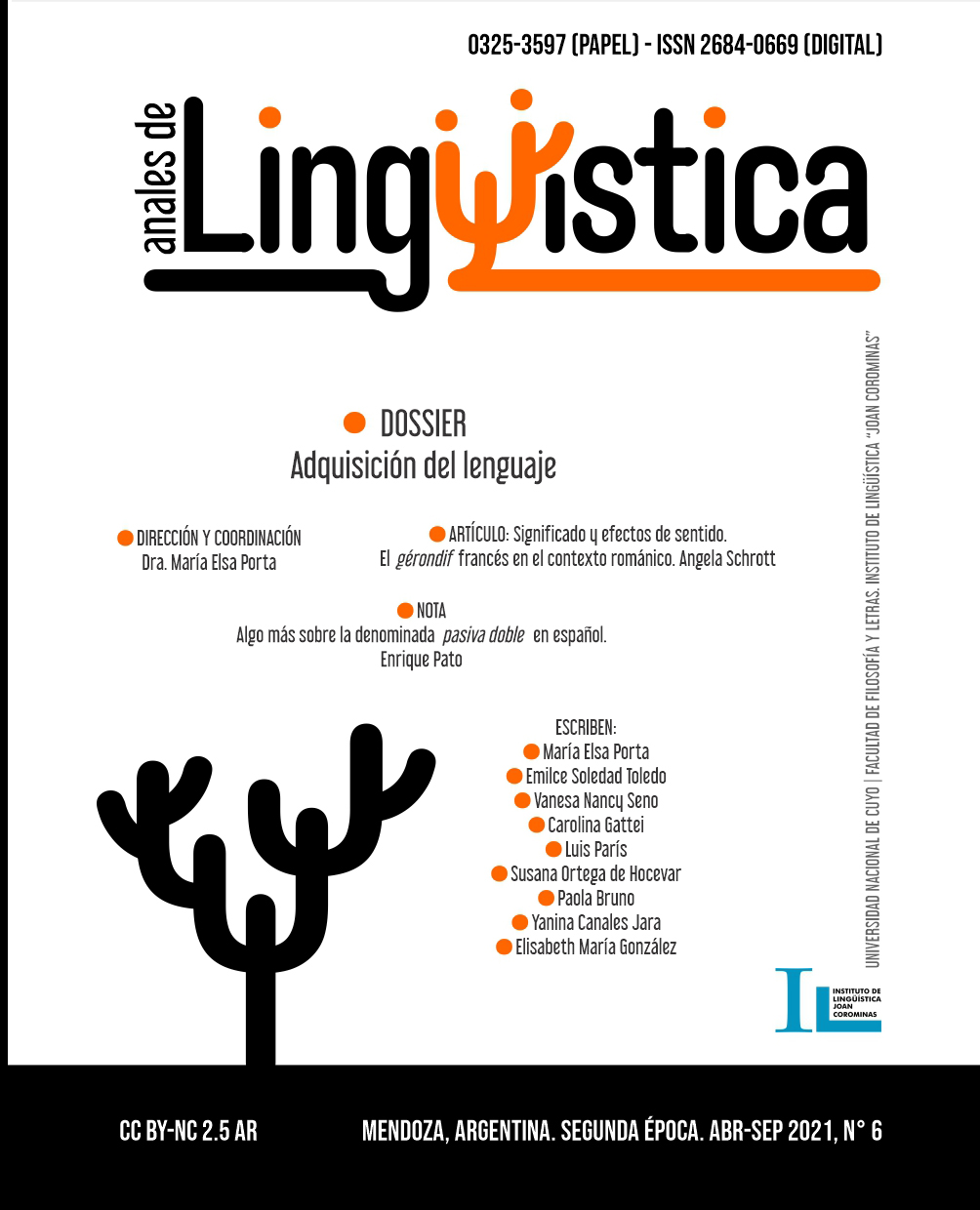Valor semántico de las estructuras morfosintácticas en niños de 3 años
Palabras clave:
Lenguaje, Semántica, Gramática, MorfosintaxisResumen
Langacker (en Cifuentes 1996:23) postula que “[…] la gramática es simplemente la estructuración y simbolización del contenido semántico”. De acuerdo con este postulado, los marcadores morfosintácticos estarían estructurados por relaciones léxico-semánticas. Para comprobar esta hipótesis, se indagó si los niños de 3 años pueden identificar verbos, sustantivos contables e incontables presentados como pseudopalabras a partir de las marcas morfosintácticas de la oración. Para tal fin, se realizó un estudio exploratorio descriptivo en 12 niños de tres años, replicando una prueba de Brown (1981:39). Al analizar los datos hallados se observó que todos los niños reconocieron las categorías gramaticales abordadas. Estos hallazgos sugieren que las estructuras morfosintácticas de las oraciones permitirían a los niños identificar la categoría de las pseudopalabras. Se concluyó que los elementos gramaticales estructurarían la representación cognitiva evocada por ellos, permitiendo el acceso al presunto significado de la pseudopalabra a partir de su forma y su función en la estructura de la oración. Esto significa que los marcadores morfosintácticos aportarían la información necesaria para localizar la categoría gramatical de las palabras y de esa forma las no palabras adquirirían un estatus de referencia por cuanto serían una “primera aproximación semántica en un contexto pragmático” (Sentis et al. 2009:148). Estos resultados confirmarían la tesis de que “[…] el léxico, la morfología y la sintaxis se conciben como un continuum de aspectos interrelacionados […]” (Cuenca y Hilferty 2007:24).
Citas
Aguado, J. y Pine, J. (2005). ¿Es totalmente productivo el uso inicial de la flexión verbal finita? un nuevo método cuantitativo para el estudio de la productividad verbal en español. En: M.A. Mayor, B. Zubiauz y E. Díez (eds.), Estudios sobre la adquisición del lenguaje (pp. 105.119). Salamanca: Universidad de Salamanca.
Brown, R. (1981). Psicolingüística: Algunos aspectos acerca de la adquisición del lenguaje. Distrito Federal: Trillas.
Cifuentes, J. L. (1996). Gramática Cognitiva: Fundamentos críticos. Madrid: Eudema. Clemente, R. A. (1996). Desarrollo del lenguaje. Barcelona: Octaedro.
Cuenca, M. J. y Hilferty, J. (2007). Introducción a la lingüística cognitiva. Barcelona: Ariel S.A.
Cuetos Vega, F., (1998). Evaluación y Rehabilitación de las afasias. Aproximación cognitiva. Madrid: Médica Panamericana.
Giammatteo, M. y Albano, H. (2009). ¿Cómo se clasifican las palabras? Buenos Aires: Biblios.
Manrique, M. (2011). Estudio de la morfología verbal en las oraciones utilizadas para la reeducación de fonemas en las propuestas de Mura (1994) y López ocio y Agustoni (1998) (tesis de grado). U.N.S.L., San Luis.
Ortega, S. y Quesada, M. (2002). Desarrollo del lenguaje verbal. Mendoza: EFE.
Raiter, A. y Jaincheco, V. (2002). Psicolingüística. Elementos de adquisición, comprensión y alteraciones del lenguaje. Buenos Aires: Docencia.
Rodríguez, O. y Berruecos, M.P. (1997). La adquisición del español como lengua materna. Estudios lingüísticos y literarios. Distrito Federal: El colegio México.
Santana, O., Carreras, F., Perez, J. R., Rodriguez, G. (2003). Relaciones morfológicas sufijales del español. Procesamiento del Lenguaje. Natural, (30), pp. 1-73. Recuperado de https://rua.ua.es/dspace/bitstream/10045/1589/1/PLN_30_01.pdf
Sebastián, E. (1991). El desarrollo del sistema de referencia temporal en español: Un paseo por la morfología verbal. Anales de Psicología, 7 (2), pp. 181-196. Recuperado de https://www.um.es/analesps/v07/v07_2/07-07_2.pdf
Sentis, F., Nusser, C., Acuña, X. (2009). El desarrollo semántico y el desarrollo de la referencia en la adquisición de la lengua materna. Onomázein, (20), pp. 153-191.
Serra, S. (2008). Fonoaudiológicamente. Nociones básicas y práctica profesional. Córdoba: Brujas.
Valle, F., Cuetos Vega, F., Igoa, J. M., del Viso, S. (1990). Comprensión y producción del lenguaje. Madrid: Alianza.
Descargas
Publicado
Cómo citar
Número
Sección
Licencia
Derechos de autor 2021 Anales de Lingüística
Esta obra está bajo una Licencia Creative Commons Atribución 2.5 Argentina.
Los/as autores/as que publican en esta revista están de acuerdo con los siguientes términos:
1. Los/as autores conservan los derechos de autor y garantizan a la revista el derecho de ser la primera publicación del trabajo bajo una licecncia Creative Commons Atribución 2.5 Argentina (CC BY 2.5 AR) . Por esto pueden compartir el trabajo con la referencia explícita de la publicación original en esta revista.
2. Anales de lingüística permite y anima a los autores a difundir la publicación realizada electrónicamente, a través de su enlace y/o de la versión postprint del archivo descargado de forma independiente.
3. Usted es libre de:
Compartir — copiar y redistribuir el material en cualquier medio o formato
Adaptar — remezclar, transformar y construir a partir del material para cualquier propósito, incluso comercialmente.























